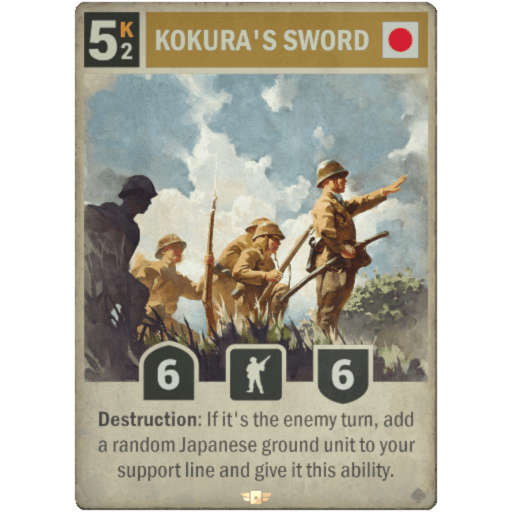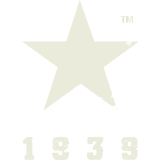
Brothers in Arms: Card Reveal Summary
Check out the image below for an overview of all cards revealed so far in the Brothers in Arms expansion!
This image is updated on a weekly basis. To ensure that you get the newest information about the latest card reveals, join us on Discord, and follow us on social media:
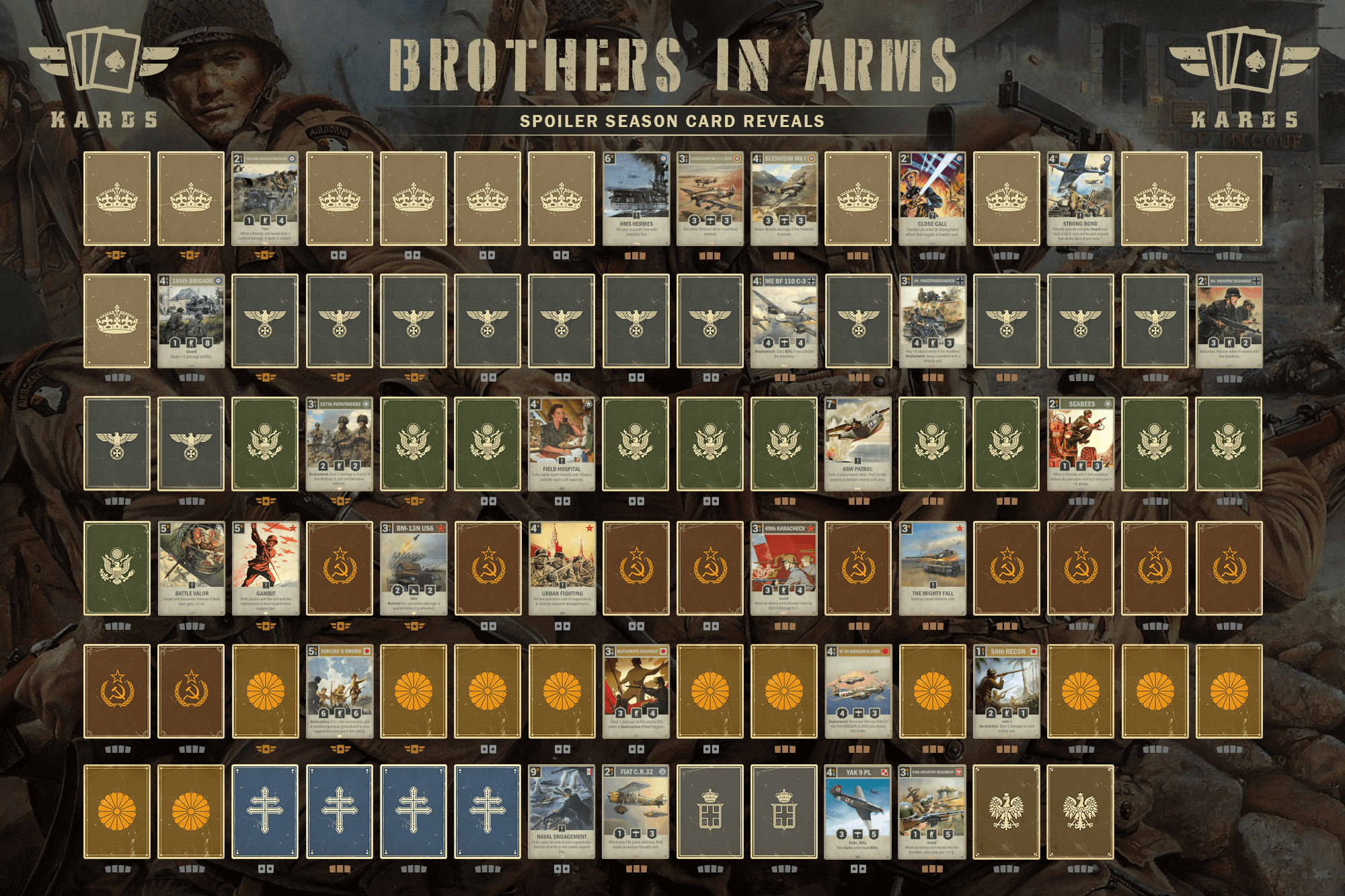
Week 1 Reveals
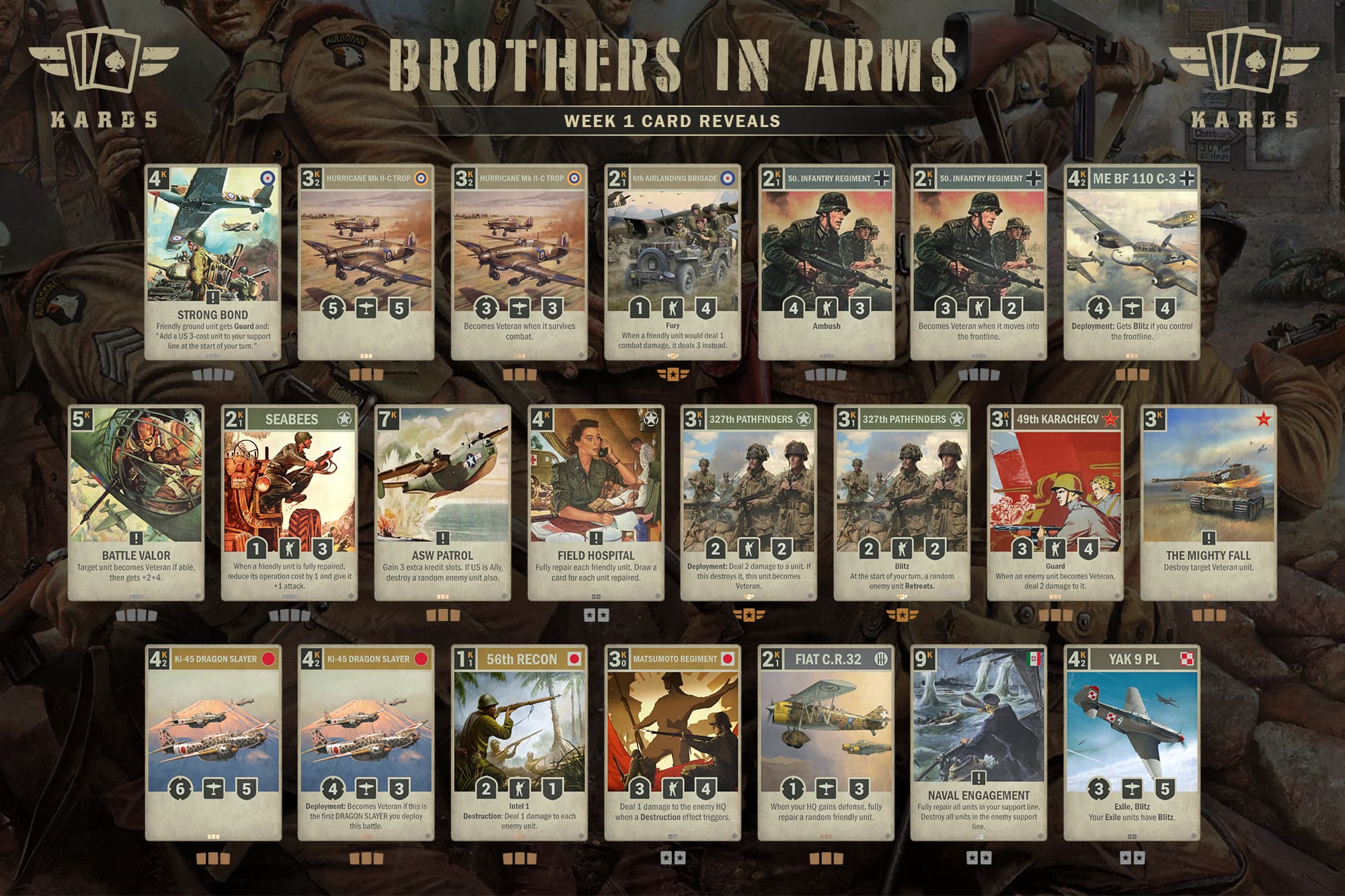
50. Infantry Regiment
The 50. INFANTRY REGIMENT is a German Infantry unit of Standard rarity with the Veteran ability. It costs 2 Kredits to play, 1 Kredit to operate, has 3 attack and 2 defense. The 50. INFANTRY REGIMENT becomes Veteran when it moves into the frontline. When it's Veteran, it has 4 attack, 3 defense, and gains the Ambush ability.
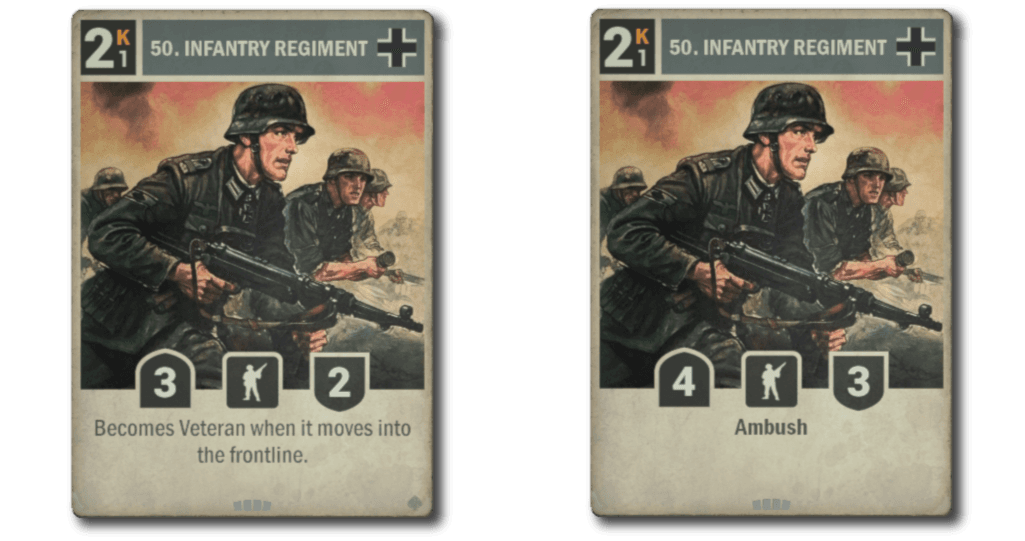
Historical Context
At the start of WWII the 50th Infantry Regiment was part of the 3rd Infantry Division of the Wehrmacht which took part in the invasion of Poland in 1939 and the invasion of France in 1940. In 1941 the regiment was transferred to the 111th Infantry Division to participate in Operation Barbarossa as part of Army Group South. The division fought around Kiev where it helped to trap and destroy the Soviet 37th Army before pushing eastwards. After the capture of Russian city Rostov-on-Don in 1941 they were forced to retreat and take up defensive positions. After some rest the 111th Infantry Division joined operation Case Blue with the 17th Army, which was a German summer offensive in 1942 with the goal of securing the Soviet oil fields in the Caucasus. Case Blue was a failure and ended with the withdrawal of the German forces and the 111th Division took up defensive positions which lasted until July 1943. After the German defeat at the Battle of Kursk in the summer of 1943 the division gradually rolled back to the west, defending various areas until it was eventually destroyed while defending Crimea. The last remnants were evacuated by ship in May 1944, and the division was disbanded.
327th PATHFINDERS
An Elite US Infantry unit, the 327th PATHFINDERS has 2 attack, 2 defense, costs 3 Kredits to play and 1 Kredit to operate. Its deployment effect deals 2 damage to a unit and, if this destroys it, the 327th PATHFINDERS becomes Veteran. In its Veteran form, this unit has Blitz and the effect that at the start of your turn, a random enemy unit Retreats.
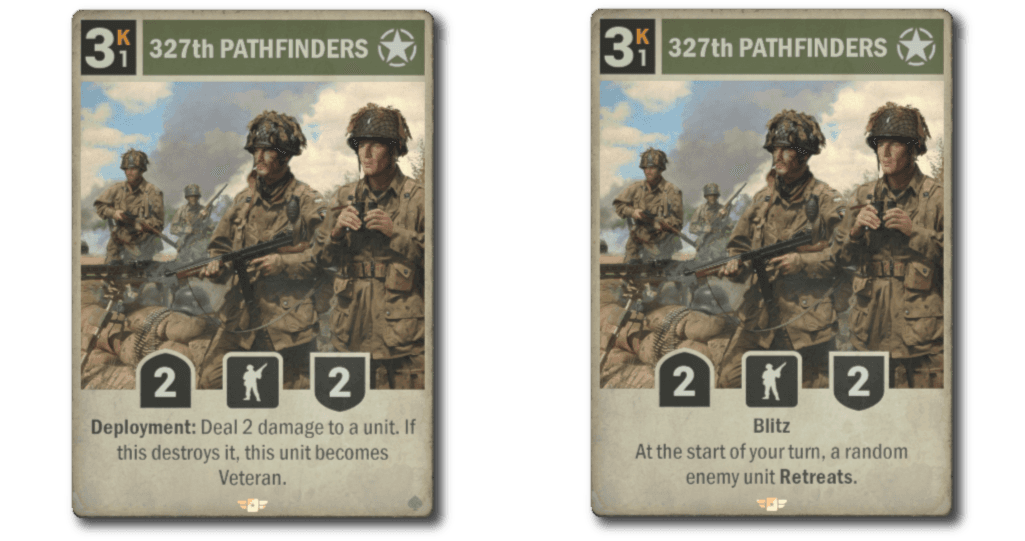
Historical Context
The Pathfinders of the 327th Glider Infantry Regiment were a specialized unit within the US Army during WWII. They were responsible for landing ahead of the main airborne forces to prepare and mark the landing zones for subsequent paratrooper drops or glider landings. The Pathfinders were trained to jump from aircraft or gliders and make their way to the designated landing zones. They would then set up beacons, signal lights, and other markers to guide the incoming aircraft. This was a crucial task, as accurate and timely delivery of troops and equipment was essential for the success of airborne operations. The 327th Glider Infantry Regiment played a vital role in several important operations during WWII, including the D-Day invasion of Normandy, the airborne assault during Operation Market Garden, and the Rhine River crossing during Operation Varsity. Additionally, in December 1944, the 327th was part of the 101st Airborne Division, which was hastily deployed to the Ardennes during the German offensive, known as the Battle of the Bulge. One of the most notable actions of the 327th Pathfinders during the battle was the defense of the town of Bastogne. For its action during the defense the regiment got its nickname “Bastogne Bulldogs”. After the Battle of the Bulge, the 327th Infantry fought in the Rhineland and Berchtesgaden offensives. Following the end of WWII, the regiment was deactivated on 30 November 1945.
STRONG BOND
The British Order STRONG BOND has the effect that a friendly ground unit gets Guard and: "Add a US 3-cost unit to your support line at the start of your turn". It costs 4 Kredits and is Standard rarity.
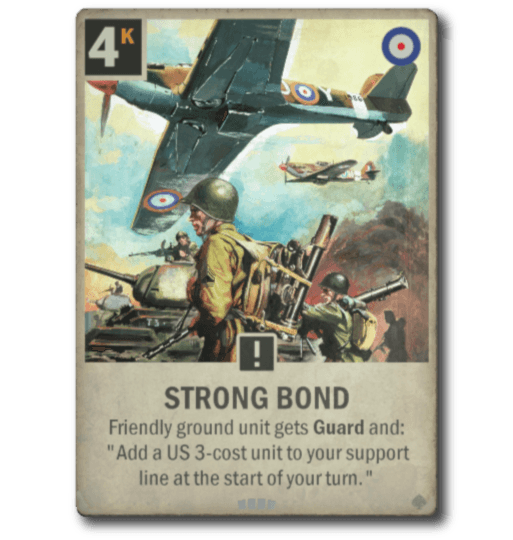
Historical Context
After the American Revolution in 1783 the UK recognized American independence and the two countries established diplomatic relations in 1785. Ever since the UK and the US have remained close partners. The UK-US relations at the start of WWII were complex as the Americans were divided on what the role of the nation should be in the war, or if it should interfere at all. However, public opinion changed, especially during the Battle of Britain, as it showed that the German war machine was not invincible, and by April 1941 a public poll showed that the majority of Americans were in favor of joining the war against the Axis. Finally the Japanese attack on Pearl Harbor on December 7, 1941, ended the debate once and for all and shortly after the US was at war with the Axis powers.
6th AIRLANDING BRIGADE
An Elite British Infantry unit, the 6th AIRLANDING BRIGADE has the Fury ability and the effect that when a friendly unit would deal 1 combat damage, it deals 3 instead. It has 1 attack, 4 defense, costs 2 Kredits to play and 1 Kredit to operate.
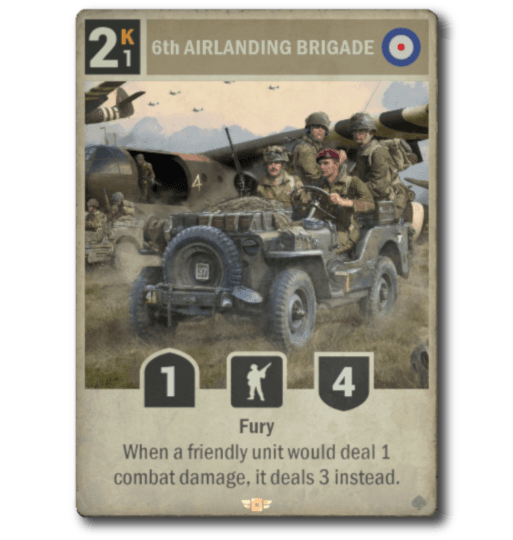
Historical Context
The 6th Airlanding Brigade was an airborne infantry brigade of the British Army during WWII. The brigade was created in 1943 and was assigned to the 6th Airborne Division, nicknamed Red Devils, along with the 3rd and 5th Parachute Brigades. The 6th Airlanding Brigade was unique among British airborne units in that it was composed entirely of glider-borne troops. The brigade consisted of three battalions of infantry, as well as supporting units such as engineers, medics, and anti-tank troops. The brigade saw action in several major operations during the war, including the Normandy landings in June 1944 and the Battle of Arnhem in September 1944. During the Normandy landings, the brigade was tasked with securing the eastern flank of the invasion area and capturing several key bridges. At Arnhem, the brigade was tasked with securing the landing zones and holding bridges over the Rhine River. The 6th Airlanding Brigade suffered heavy losses during both operations, with many of its troops killed, wounded, or captured. However, the brigade's actions were critical in the success of these operations. After the war, the 6th Airlanding Brigade was disbanded.
49th KARACHEV
A Soviet Infantry unit of Limited rarity, the 49th KARACHEV has the Guard ability and, when an enemy unit becomes Veteran, deals 2 damage to it. It has 3 attack, 4 defense, costs 3 Kredits to play and 1 Kredit to operate.
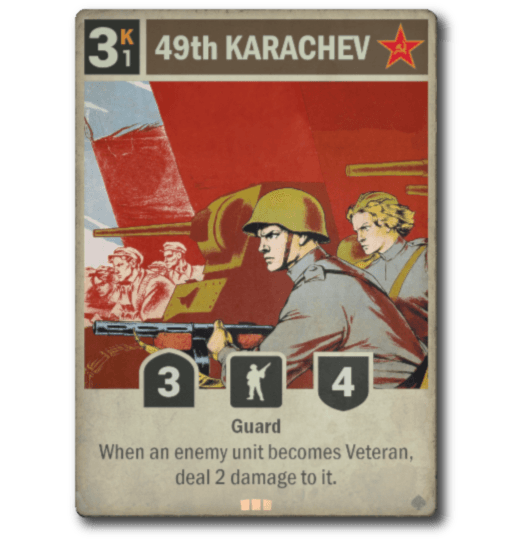
Historical Context
During WWII the 49th Guards Rifle Regiment was part of the 16th Guards Rifle Division, which was a highly decorated and elite infantry division of the Red Army during Great Patriotic War. It was formed in February 1942 and served in various fronts throughout the war. It was initially assigned to Kalinin Front and later transferred to Western Front's 30th Army where it took part in the struggle for the village of Polunino. It then fought in various battles and operations and was eventually reassigned to the 11th Guards Army, with which it served for the rest of the war. During the summer offensive against the German-held salient around Oryol, it assisted in the liberation of Karachev and received its name as an honorific. The division participated in the liberation of key cities like Orsha, Minsk, and Königsberg (today known as Kaliningrad), and was highly decorated for its actions. It remained in the Kaliningrad Oblast well after the war until it was finally disbanded in September 1960.
THE MIGHTY FALL
THE MIGHTY FALL is a Soviet Order of Limited rarity. It costs 3 Kredits to play and has the effect "Destroy target Veteran unit".
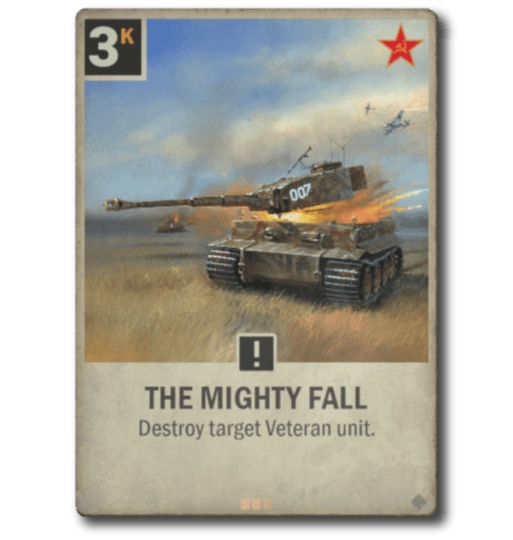
Historical Context
At the start of Operation Barbarossa (the German invasion of the Soviet Union), the Soviet Union and the Red Army had a huge disadvantage, militarily, productionally and technologically. However, at the start of 1943 they started gaining the upper hand in a series of significant turning points. This started with their victory in the Battle of Stalingrad in February 1943, followed by The Battle of Kursk in July 1943, and finally the Operation Bagration (June-August 1944). It's also important to note that the Soviet Union's ability to produce weapons and equipment on a massive scale, combined with its vast resources and manpower, was a crucial factor in their overall success. While Germany initially had the upper hand in certain technological aspects, the Soviet Union's determination, industrial capacity, and strategic planning allowed them to catch up and ultimately overcome Germany's technological and military advantages.
BATTLE VALOR
BATTLE VALOR is a Standard US Order that costs 5 Kredits to play. It has the effect that a target unit becomes Veteran if able, then gets +2 +4.
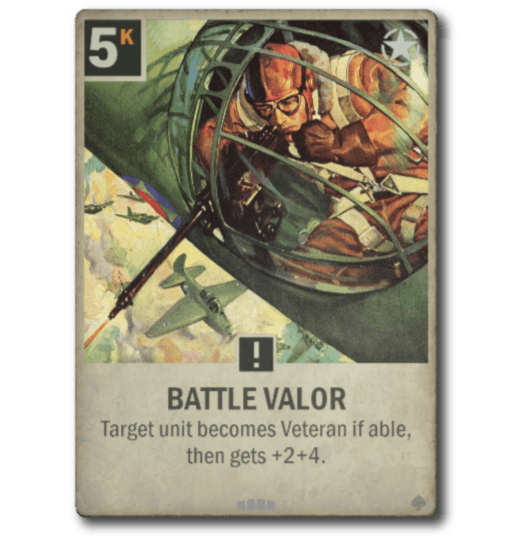
Historical Context
While it is difficult to provide precise numbers, machine gunners in bombers did contribute to shooting down enemy aircraft, especially when engaged in defensive actions. The primary objective of bomber gunners was to deter and suppress attacks rather than achieving high numbers of aerial victories. The role of bomber machine gunners was essential for the survival of the bomber crews and the success of their missions, even if their individual success rates in shooting down enemy planes were relatively modest. However, heroic actions of USAF machine gunners during WWII are numerous and what follows is an example. Staff Sergeant Maynard Harrison Smith served as a ball turret gunner on a B-17 Flying Fortress during World War II. On May 1, 1943, his aircraft was attacked by numerous German fighters during a mission over France. Smith's aircraft sustained heavy damage, and the tail section was severed, leaving the plane in imminent danger of breaking apart. Despite this, Smith remained at his position, providing covering fire and protecting the crew. He refused to abandon his post until ordered to do so as the aircraft began to disintegrate. Smith's dedication and selflessness earned him the Medal of Honor.
FIELD HOSPITAL
FIELD HOSPITAL is a Special US Order that costs 5 Kredits to play. When played, you fully repair each friendly unit and draw a card for each unit repaired.
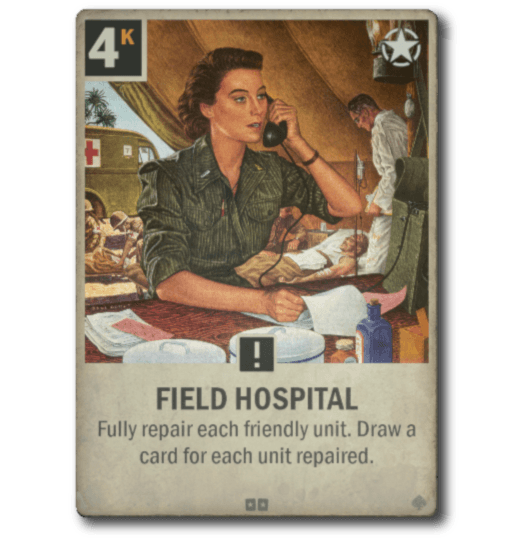
Historical Context
During WWII, US field hospitals played a crucial role in providing medical care to wounded soldiers on the front lines. These field hospitals were mobile units designed to provide emergency medical treatment and stabilize injured personnel before they could be transported to more extensive medical facilities. The United States made several notable contributions and innovations in the field of military medicine during the war. For example the first trials of Mobile Army Surgical Hospitals (MASH) were established by the U.S. Army, which was a significant innovation. These mobile surgical hospitals brought advanced surgical capabilities closer to the front lines, reducing the time between injury and surgical intervention. Another innovation was Blood Plasma and Component Therapy which the US military played a crucial role in developing and implementing during the war. This development significantly improved the management of casualties and contributed to better outcomes. It's important to note that while the United States made significant contributions in these areas, other nations also made important advancements in military medicine during WWII. Also note that many medical professionals and researchers from various countries worked together and independently to improve the care and outcomes for wounded soldiers.
MATSUMOTO REGIMENT
The MATSUMOTO REGIMENT is a Special Japanese Infantry unit that costs 3 Kredits to deploy and 0 Kredits to operate. It has 3 attack, 4 defense, and deals 1 damage to the enemy HQ when a Destruction effect triggers.
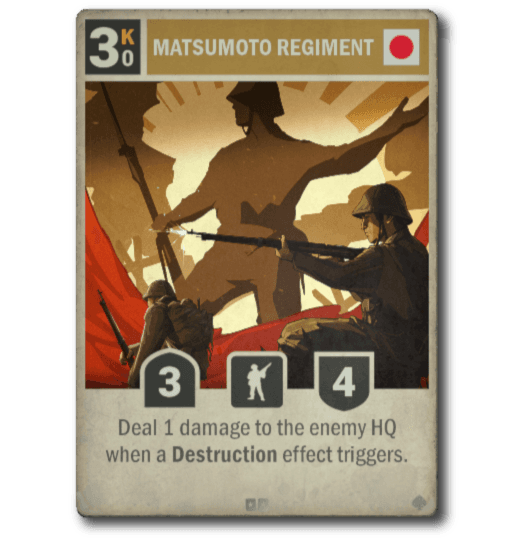
Historical Context
The 50th Infantry Regiment (Matsumoto) was a unit of the 29th Division of the Imperial Japanese Army, which was active from 1941-1945. From 1941 the 29th division was tasked with the defense of the Liaoyang area in Manchukuo state of Manchuria, but in 1944 the majority of the division, which consisted of the 18th and 38th infantry regiments, was deployed to Guam island along with the 48th Independent Mixed Brigade. Meanwhile, smaller units were dispatched to Tinian and Rota islands. The Japanese garrison on Tinian consisted of approximately 9,000 soldiers, including the 50th Infantry Regiment and the 29th tank company, who were well-fortified and prepared for the American invasion. The Battle of Tinian began on July 24, 1944, with a massive bombardment of the island by the US Navy and Army Air Forces. The Japanese defenders, however, remained dug in and refused to surrender despite overwhelming odds. By 30 July the remnants of the defenders were holed up in caves and ravines on the south portion of the island. Realizing the futility of further resistance, Colonel Ogata ordered his forces to launch a massive banzai charge. This desperate attempt resulted in heavy casualties for the Japanese, but the battle continued for a few more days until organized resistance was effectively crushed on 3 August 1944. Only about 200 men of the Japanese garrison survived the fighting.
56th RECON
56th RECON is a Japanese Infantry unit of Limited rarity. It has 2 attack, 1 defense, costs 1 Kredit to play and 1 Kredit to operate. It has Intel 1 and the Destruction effect to deal 1 damage to each enemy unit.
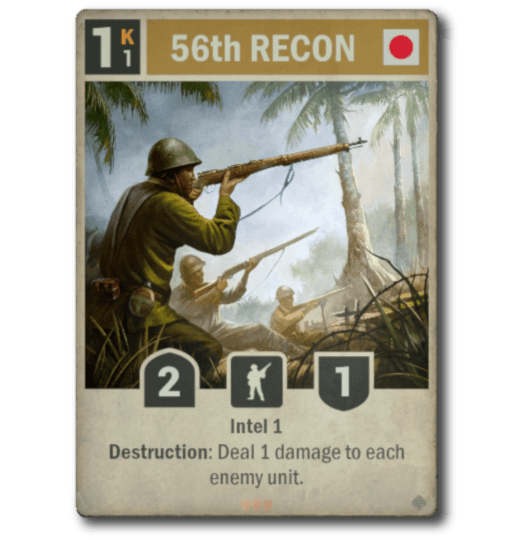
Historical Context
The 56th Reconnaissance Regiment was a motorized unit of the 56th Division of the Imperial Japanese Army, which was active 1940-1945. Initially, the 56th Division was intended as reinforcements for the Japanese invasion of Malaya but was attached to the 25th Army and sent to Burma in March 1942. The Division played a significant role in the Battle of Toungoo, where it linked with the 55th Division, and forced the Chinese to evacuate the city, paving the way to the east. The 56th Division defeated the Chinese 6th Corps in several battles, including Mawchi, Bawlake, Bato, Taunggyi, and Loikaw. It advanced north through the Shan States, took the city of Lashio, and cut off much of the local Chinese Army from China, forcing the Allies to evacuate Burma. After May 1942, the 56th Division mostly performed garrison duties on the Yunnan border. In January 1944, the division participated in the Battle of Northern Burma and Western Yunnan campaign, where it played a significant role in shattering Merrill's Marauders in the Siege of Myitkyina and delaying the Chinese forces during the Battle of Mount Song. The Division suffered heavy losses and was removed from the front line in October 1944. On the day of the surrender of Japan, August 15, 1945, the division was stationed on the border between South Burma and Thailand.
YAK 9 PL
The YAK 9 PL is a Special Polish Fighter with Exile and Blitz abilities and grants Blitz to your Exile units. It has 3 attack, 5 defense, costs 4 Kredits to play and 2 Kredits to operate.
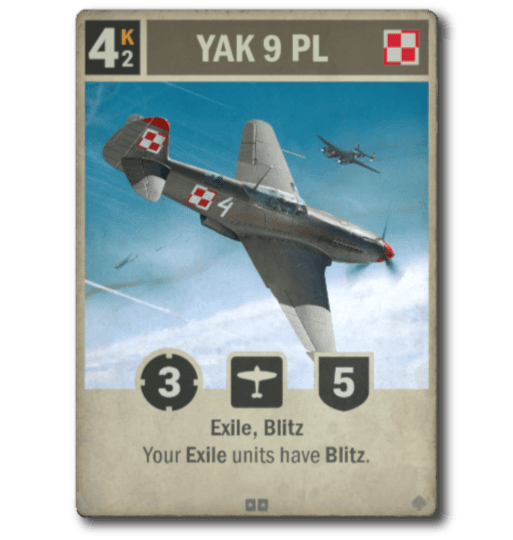
Historical Context
The Yakovlev Yak 9 was a Soviet fighter aircraft that played a significant role in the Soviet Air Force during WWII. It was a development of the earlier Yak 7 and Yak 1 fighters, incorporating improvements and modifications based on combat experience.The Yak 9 was designed by Alexander Yakovlev and entered service with the Soviet Air Force in 1942. It was a versatile aircraft that saw action in various roles, including air superiority, ground attack, and escort missions. The aircraft was known for its agility, robustness, and adaptability. While the majority of the Polish Air Force was disbanded or incorporated into foreign air forces after the German and Soviet occupations of Poland, a significant number of Polish pilots managed to escape and join Allied air forces. Some of these Polish pilots, while serving in Soviet-controlled units, flew Soviet aircraft, including the Yak 9. The most notable example is the Air Force of the Polish Army which was created alongside the Polish People's Army, a subordinate to the Red Army. It was the primary Polish air force formation within the Polish Armed Forces in the East during WWII.
FIAT CR.32
The FIAT CR.32 is a Limited Italian Fighter that costs 2 Kredits to play and 1 Kredit to operate. It has 1 attack, 3 defense, and the effect that when your HQ gains defense, you fully repair a random friendly unit.
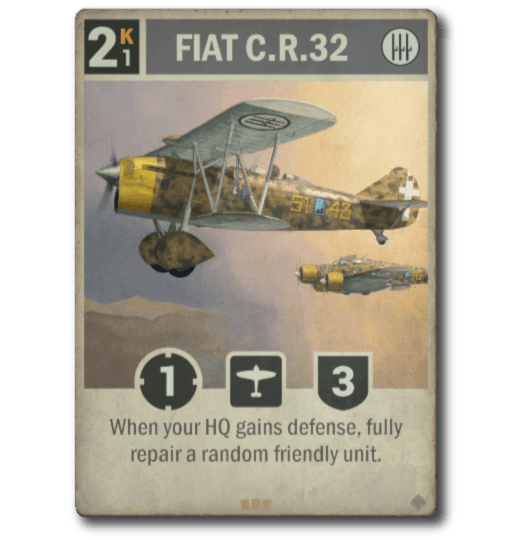
Historical Context
The FIAT CR.32 was an Italian biplane fighter aircraft that saw significant use during the interwar period and the early years of WWII. It was designed by the Italian manufacturer FIAT and entered service with the Regia Aeronautica (Italian Royal Air Force) in 1933.
During the Spanish Civil War (1936-1939), the FIAT CR.32 gained its reputation as one of the best biplane fighters of its time. It demonstrated excellent maneuverability and agility, making it highly effective in aerial combat. Its robust construction and good diving capabilities also added to its combat ability. However, by the outbreak of WWII in 1939, the FIAT CR.32 was already becoming outdated compared to the monoplane fighters that other nations were deploying. It was gradually phased out of frontline service in the Regia Aeronautica, being replaced by more modern aircraft like the Macchi C.200 and C.202. During the early stages of the war, the FIAT CR.32 continued to see limited use by Italy and its allies and it was used in various combat theaters, including North Africa, the Mediterranean, and the Balkans. By the mid-1940s, the FIAT CR.32 was mostly relegated to secondary roles, such as training, reconnaissance, and ground-attack missions. It was gradually phased out of service as more advanced aircraft became available. Nonetheless, it is worth noting that a few CR.32s remained in use until the end of the war in 1945.
HURRICANE Mk II-C TROP
HURRICANE Mk II-C TROP is a Limited British Fighter. It has 3 attack, 3 defense, costs 3 Kredits to play and 2 Kredits to operate. It is a Veteran unit, which becomes Veteran when it survives combat. In its Veteran form, it has 5 attack and 5 defense.
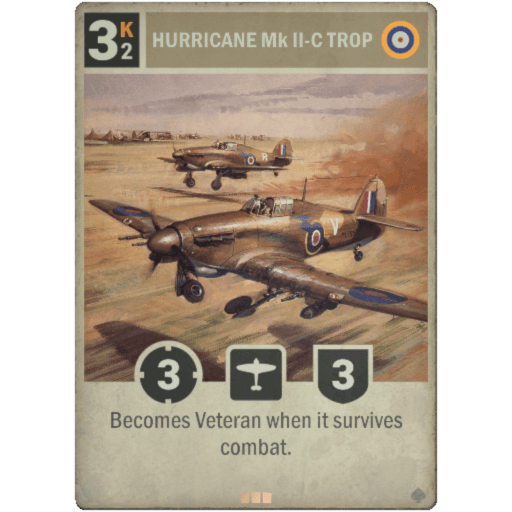
Historical Context
The Hurricane Mk II variant first saw service in 1940, with a more powerful engine and gradually improved armament. The Hurricane's main advantage over the Spitfire was that it was easier to fly, which was useful because squadrons were full of inexperienced pilots, and its gun platform was easier to handle than the Spitfire's. The unprotected fuel tank in front of the cockpit, on the other hand, could rupture and cause serious burn injuries to the pilot if hit. The wooden and fabric rear fuselages were also more prone to catching fire than metal fuselages. Despite its flaws, the Hurricane shot down the vast majority of enemy aircraft claimed by the RAF.
The Hawker Hurricane and other aircraft were tropicalized, or "trop" for use in North Africa. They were given engine dust filters as well as a desert survival kit for the pilots.
Ki-45 DRAGON SLAYER
The Ki-45 DRAGON SLAYER is a Limited Japanese Fighter. It has 4 attack, 3 defense, costs 4 Kredits to deploy and 2 Kredits to operate. Its deployment effect makes it become Veteran if this is the first DRAGON SLAYER you deploy in the battle. When it's Veteran, the Ki-45 DRAGON SLAYER has 6 attack and 5 defense.
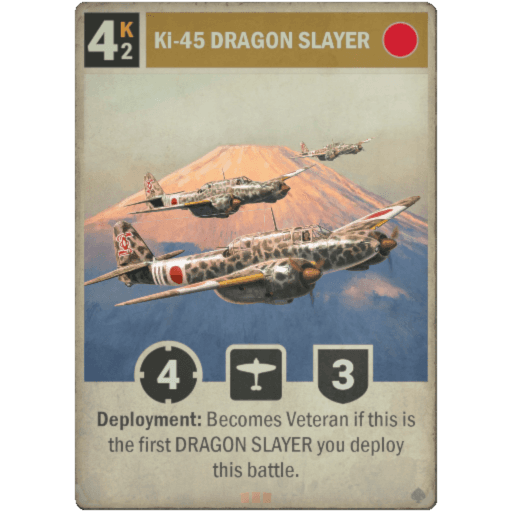
Historical Context
The Ki-45, also known as "Nick" by the Allies, was a twin-engine fighter aircraft developed by the Japanese during WWII. Its official name was "Toryu," which means Dragon Slayer in Japanese. The Ki-45 was initially designed as a heavy fighter for the Imperial Japanese Army Air Service, intended to serve as both an interceptor and a bomber destroyer. It first flew in January 1939 and entered service in 1941. The usual weaponry of the Kawasaki Ki-45 Toryu included a 20mm cannon located in the nose, a 37mm cannon firing forwards from the fuselage, a 7.92mm machine gun that fired from the rear, and the capability to carry drop tanks or bombs under the wings. Other experimental armaments were also tested, such as the use of a 75mm cannon for assaulting ships. The Ki-45 was used in a variety of roles during the war, including as an night fighter, interceptor, bomber escort, and fighter bomber aircraft. It was involved in many major battles, including the defense of the Japanese homeland during the Allied bombing campaign, as well as in the Pacific and Southeast Asia. Despite its formidable armament and performance, the Ki-45 suffered from a number of design flaws that limited its effectiveness and the aircraft's heavy armament and armor made it less maneuverable than other contemporary fighters. A total of 1,701 Ki-45 were manufactured, including a few variants.
SEABEES
SEABEES is a Standard US Infantry unit with 1 attack and 3 defense. When a friendly unit is repaired, you reduce its operation cost by 1 and give it +1 attack. It costs 2 Kredits to play and 1 Kredit to operate.

Historical Context
The Navy Seabees, officially known as the United States Naval Construction Battalions, were formed in 1942 during WWII. Composed of skilled workers enlisted or drafted into the Navy, they played a vital role in constructing and maintaining military bases, airfields, roads, bridges, and other infrastructure in support of Allied operations. In the Pacific theater, the Seabees were crucial in the island-hopping campaign, building facilities in hostile environments like Guadalcanal, Tarawa, Iwo Jima, and Okinawa. They rapidly constructed airfields and bases, often under enemy fire. In Europe, they built temporary harbors and ports to support the Normandy invasion, including the innovative Mulberry harbors. The Seabees were known for their speed, efficiency, and motto "We build, we fight." They completed over 30,000 construction projects, including more than 400 advanced bases and airfields. Despite their primary construction role, they also engaged in combat, defending their sites and participating in offensive operations.
NAVAL ENGAGEMENT
NAVAL ENGAGEMENT is a Special Italian Order that repairs all units in your support line and destroys all units in the enemy support line. It costs 9 Kredits to play.

Historical Context
Although the Italian Navy (Regia Marina) was outmatched by the British fleet in the Mediterranean during WWII, there were a few instances where they achieved success.
In the Second Battle of Sirte, which took place in March 1942, the Italian Navy, once again under Admiral Angelo Iachino's command, protected a convoy of supply ships en route to North Africa. Engaging British warships, the Italian fleet damaged the cruiser HMS Cleopatra and sank the destroyer HMS Kingston.
In the Battle of Cape Spartivento in November 1940, Admiral Inigo Campioni led the Italian Navy in a confrontation with the British Mediterranean Fleet. Italian cruisers and destroyers successfully defended a convoy bound for North Africa, causing damage to British ships. The Italian Navy managed to escape without significant losses.
However, during the Allied Invasion of Sicily in 1943, the Italian Navy was overwhelmed by the superior Allied naval forces. The Italian fleet was largely neutralized, with several ships being captured or scuttled by their own crews to prevent them from falling into enemy hands. This led to the eventual surrender of the Italian Navy to the Allies in September 1943. Subsequently, the Italian fleet was either disarmed or incorporated into Allied naval operations for the remainder of the war.
ME BF 110 C-3
The ME BF 110 B-2 is a German Fighter of Limited rarity. It has 4 attack, 4 defense, costs 4 Kredits to play and 2 Kredits to operate. It has the deployment effect that it gets the Blitz ability if you control the frontline.
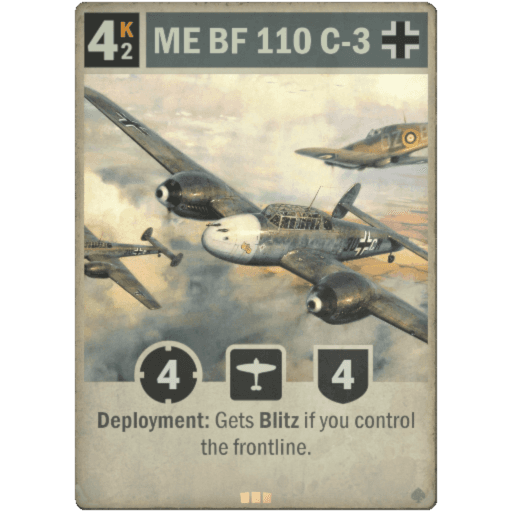
Historical Context
The Messerschmitt Bf 110, also known as the ME BF 110, was a twin-engine heavy fighter and fighter-bomber aircraft used by the Luftwaffe during WWII. The Bf 110 B-2 was one of its early variants and was mainly used for reconnaissance roles and had a reduced armament compared to other variants. It was equipped with two 7.92mm MG 17 machine guns in the nose and two 7.92mm MG 15 machine guns in the rear cockpit for defensive purposes. The Bf 110 B-2 had a range of up to 2,000 km (1,240 miles) thanks to its long-range fuel tanks and was equipped with a variety of cameras and other sensors to gather intelligence on enemy positions, movements, and activities. Later variants of the Bf 110, such as the C and D models, had improved armament and were used in a variety of roles including as bomber destroyers, night fighters, and ground attack aircraft. However, the Bf 110 B-2 variant remained in use for reconnaissance missions throughout the war.
ASW PATROL
ASW PATROL is a Limited US Order which costs 7 Kredits to play. When played, gain 3 extra Kredit slots. If US is Ally, destroy a random enemy unit also.
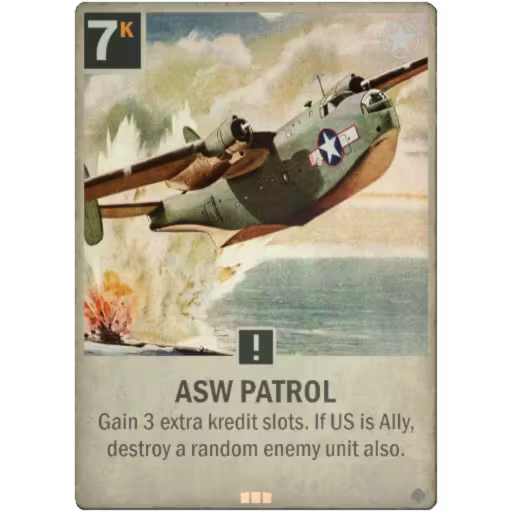
Historical Context
During WWII, ASW Patrol (Anti-Submarine Warfare Patrol) operations were crucial in countering the threat of German U-boats. Their mission was to protect convoys, naval vessels, and supply lines from submarine attacks. ASW Patrols utilized a variety of assets such as destroyers, frigates, corvettes, patrol boats, and aircraft equipped with sonar systems, depth charges, and other anti-submarine weapons. Tactics included using sonar to detect underwater contacts, employing depth charges for attacks, and coordinating assaults with multiple vessels. ASW Patrols also provided escort duty to merchant convoys, deterring U-boats from attacking. Close cooperation between naval vessels, aircraft, and shore-based command centers was crucial for intelligence gathering and coordinated attacks. Technological advancements improved ASW capabilities, with more sophisticated sonar systems and weapons like hedgehog mortars and squid mortars. Allied success in countering U-boats turned the tide in the Battle of the Atlantic and secured vital supply lines which allowed for the transport of troops, equipment, and supplies to their military campaigns.
Week 2 Reveals
185th BRIGADE
The 185th BRIGADE is a British Infantry unit of Standard rarity. It has 1 attack, 8 defense, costs 4 Kredits to play and 1 Kredit to operate. The 185th BRIGADE has the Guard ability and, additionally, deals +3 damage to HQs.
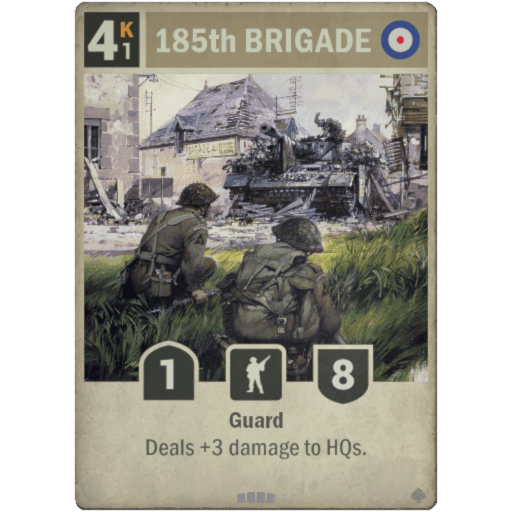
Historical Context
The 185th Infantry Brigade of the British Army was formed in September 1942 and started as a Home Defense formation in the northern part of the UK. In 1943 it was assigned four frontline battalions: 2nd Battalion - Royal Warwickshire Regiment, 1st Battalion of the Royal Norfolk Regiment, 2nd Battalion of the King’s Shropshire Light Infantry and the 1st Battalion of the Highland Light Infantry. At first the brigade was a part of the 79th Armored Division, but as of April 1943 it was transferred to the 3rd Infantry Division and started training for Operation Overlord. On D-Day, June 1944, the 3rd Infantry Division was set to land at Sword beach which was the responsibility of the British Army and a naval bombardment force provided by the British Royal Navy plus Polish, Norwegian and other Allied navies. Sword beach was the smallest of the D-Day landing beaches and only wide enough for a brigade sized landing (ca. 20 men). The goal was to get enough troops ashore and link up with the Canadians at Juno, and from there they were supposed to push inland and capture Caen. By the end of D-day, 29,000 men had been successfully landed at the beach, and 630 casualties had been taken in the fight, mostly during the only German counteroffensive that was made on June 6. However, the major objective which was the capture of Caen was still out of reach and what followed was 6 weeks of fierce fighting for the city known as the Battle for Caen. After that, the 185th Brigade engaged in combat at Bourguebus Ridge, Mont Pincon, the Nederrijn, the Rhineland, and on the other side of the Rhine. By the end of the war the 185th Brigade had lost more soldiers than the other two infantry brigades of the 3rd Infantry Division and received two Victoria Crosses for its act of bravery during the conflict.
35th INFANTRY REGIMENT
The 35th INFANTRY REGIMENT is a Polish Infantry unit with the Guard ability and, when an enemy unit moves into the frontline, your units get +1 +1. It has 1 attack, 5 defense, costs 3 Kredits to play and 1 Kredit to operate.
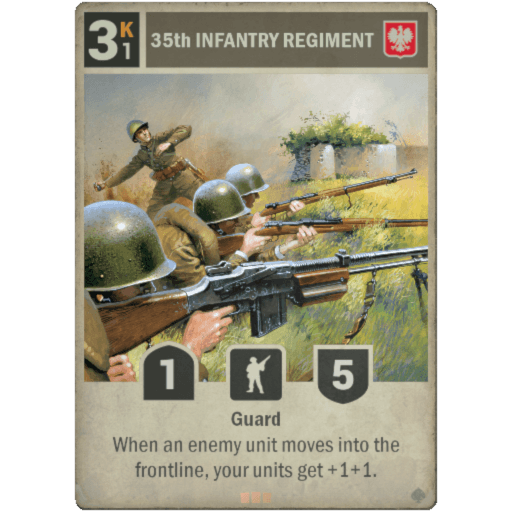
Historical Context
At the outbreak of WWII 35th Infantry Regiment was part of the 9th Infantry Division, also known as the 9th Infantry "Wielkopolska" Division, and was one of the major divisions of the Polish Army during the war. The division was formed in 1919 and played a significant role in the defense of Poland during the German invasion in September 1939, including the Battle of Bzura, where it was defeated by the German forces.After defeat, the 9th Infantry Division gathered but was attacked by the Luftwaffe. The division scattered and ceased to exist, except for the 35th Infantry Regiment which broke out of the German encirclement. Later in the war, the 9th Infantry Division was reconstituted as part of the Polish Armed Forces in the West and participated in the Italian Campaign, contributing to the liberation of Italy.
BLENHEIM Mk I
The BLENHEIM Mk I is a Limited British Bomber unit. It costs 4 Kredits to play, 2 Kredits to operate, has 3 attack and 3 defense. It deals double damage of the frontline is empty.
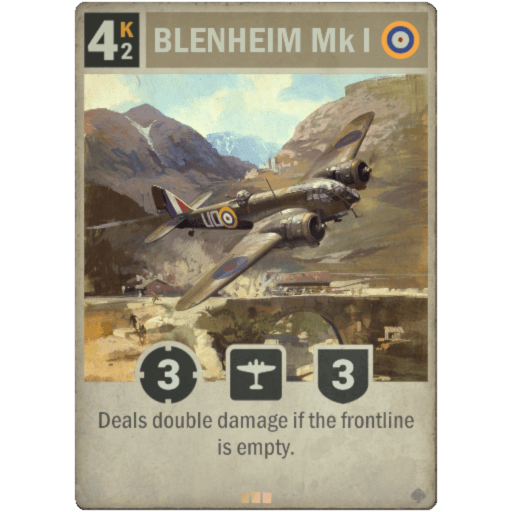
Historical Context
The Bristol Blenheim was a British light bomber, heavy fighter and night fighter and it first came into service in 1937 as the first British aircraft with an all metal skin construction. By the outbreak of WWII the Blenheim had become more or less obsolete, but was used during the Battle of France for shorter bomber missions against German targets where it performed poorly and many aircraft were lost to enemy aircraft and anti aircraft artillery. The Blenheim’s saw more success as an early type of night fighter, but by 1941 the Blenheim was deemed inadequate for current operations and was phased out by more capable aircraft such as the Beaufighters and later the De Havilland Mosquitos. By 1944 a total of 4,422 aircraft had been built, including variants.
HMS HERMES
A British Order card of Limited rarity, the HMS HERMES costs 6 Kredits to play and, when played, fills your support line with SWORDFISH.
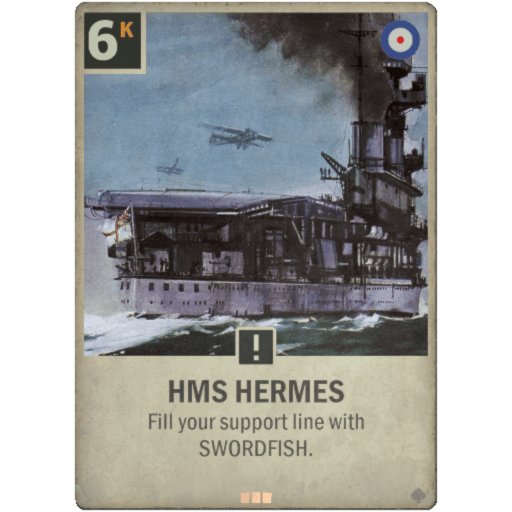
Historical Context
HMS Hermes was a British aircraft carrier and the first ship to be designed as an aircraft carrier, although it took so long for it to be built that during its construction that in the meantime the Japanese Navy built and launched the Hōshō. HMS Hermes was commissioned in 1924, and at the time of her launch was the largest aircraft carrier in the world. During the interwar years, she was involved in a number of operations and was often used to showcase British naval power around the world. When WWII broke out, HMS Hermes was immediately put to use. In 1939, she operated in the western Atlantic, where she helped to prevent German U-boats from attacking British shipping. In 1940, she was sent to the Indian Ocean, where she continued to support British and Allied operations. Despite being outdated and vulnerable, HMS Hermes performed admirably well and her aircraft were able to inflict significant damage on Japanese troops and shipping, and helped to slow the Japanese advance. However, on April 9, 1942, she was caught by surprise and attacked by Japanese carrier-based aircraft in the Indian Ocean, off the coast of Ceylon (now Sri Lanka). The attack was devastating, and within minutes HMS Hermes was hit by several bombs and torpedoes. The damage was catastrophic, and the ship quickly sank, taking over 300 men with her. Her loss was a major blow to the British war effort in the Far East, and marked the first time in history that an aircraft carrier had been sunk by enemy aircraft while at sea.
39. PANZERGRENADIER
The 39. PANZERGRENADIER is a Limited German Infantry unit with 4 attack and 3 defense. It costs 3 Kredits to play and 1 Kredit to operate. While in the frontline, it has +2 attack. It also has the following deployment effect: swap a position with a friendly unit.
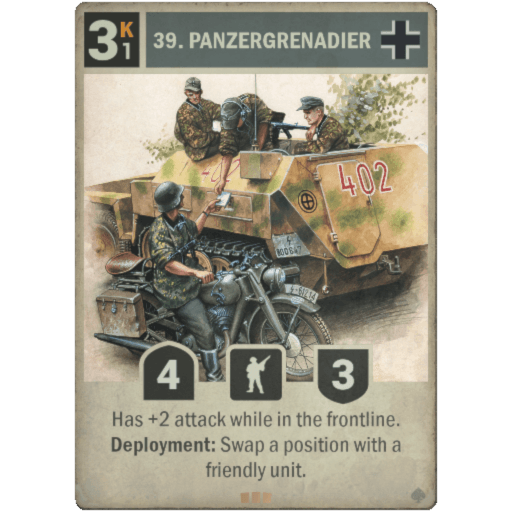
GAMBIT
An Elite Soviet Order, GAMBIT costs 5 Kredits to play and has the effect, that both players add the unit with the highest cost in their hand to their support line.
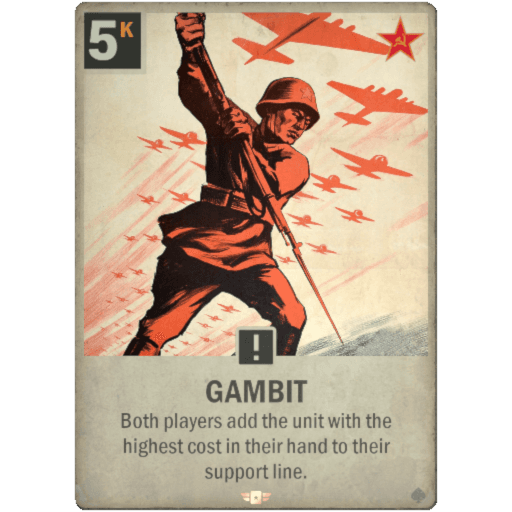
CLOSE CALL
CLOSE CALL is a Standard British Countermeasure. It costs 2 Kredits to activate and has the following effect: when a friendly unit is targeted by an Order or deployment effect, counter the effect.
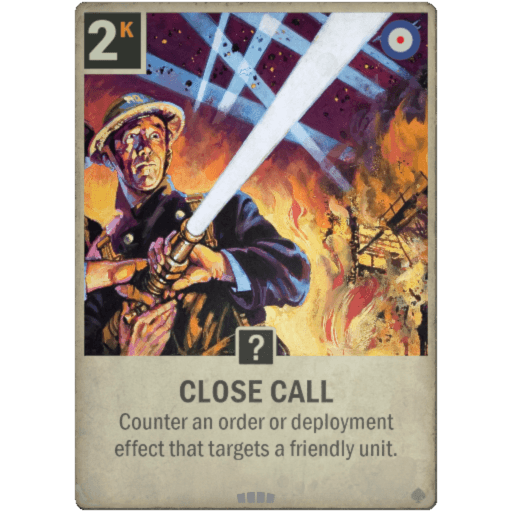
URBAN FIGHTING
URBAN FIGHTING is a Special Soviet Order. It costs 4 Kredits to play and has the effect, to set the operation cost of target unit to 4, and destroy adjacent damaged units.
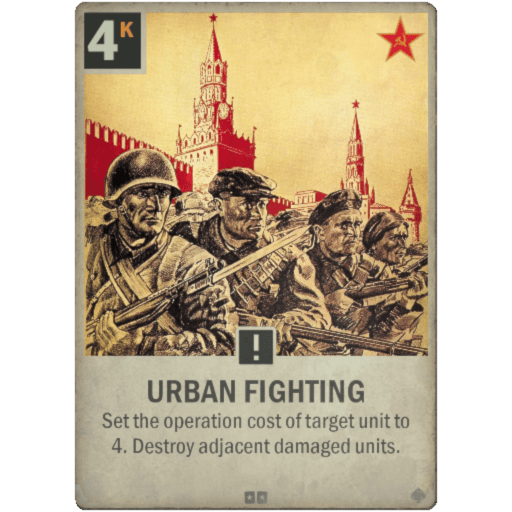
BM-13N US6
The BM-13N US6 is an Elite Soviet Artillery unit with 2 attack, 2 defense, the Blitz ability and the effect: "Retreat this unit before damage is applied when it is attacked". It costs 3 Kredits to play and 1 Kredit to operate.
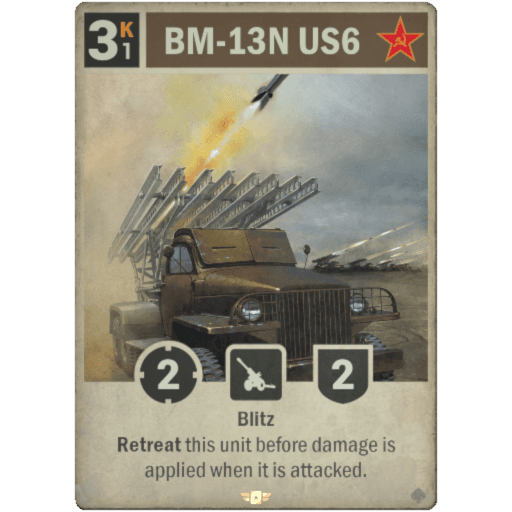
KOKURA'S SWORD
KOKURA'S SWORD is en Elite Japanese Infantry unit with 6 attack and 6 defense. It costs 5 Kredits to deploy and 2 Kredits to operate. It has a destruction effect where, if it's the enemy's turn, you add a Japanese unit to your support line and give it this ability.
